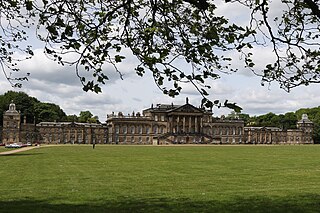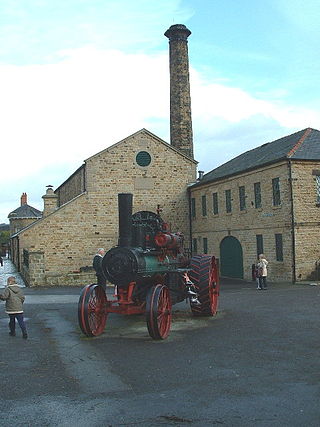
Wentworth Woodhouse is a Grade I listed country house in the village of Wentworth, in the Metropolitan Borough of Rotherham in South Yorkshire, England. It is currently owned by the Wentworth Woodhouse Preservation Trust. The building has more than 300 rooms, although the precise number is unclear, with 250,000 square feet (23,000 m2) of floorspace. It covers an area of more than 2.5 acres (1.0 ha), and is surrounded by a 180-acre (73 ha) park, and an estate of 15,000 acres (6,100 ha).

Kakiemon is a style of Japanese porcelain, with overglaze decoration called "enameled" ceramics. It was originally produced at the factories around Arita, in Japan's Hizen province from the Edo period's mid-17th century onwards. The style shares much in common with the Chinese "Famille Verte" style. The quality of its decoration was highly prized in the West and widely imitated by major European porcelain manufacturers during the Rococo period.

Wentworth is a village and civil parish in the Metropolitan Borough of Rotherham in South Yorkshire, England.

Swinton is a town in the Metropolitan Borough of Rotherham, in South Yorkshire, England on the west bank of the River Don. It has a population of 15,559 (2011). The town is five miles north-northeast of the larger town of Rotherham and directly west-southwest of Mexborough. The original junior and infant school building built 1852 on Church Street formerly Fitzwilliam School still exists being converted into residential apartments called 'Fitzwilliam Lodge'

Elsecar Heritage Centre is a living history centre in Elsecar, Barnsley, England. It covers the industrial history of the area, and includes a Newcomen steam engine, the only such engine still in its original location.

The Rockingham Pottery was a 19th-century manufacturer of porcelain of international repute, supplying fine wares and ornamental pieces to royalty and the aristocracy in Britain and overseas, as well as manufacturing porcelain and earthenware items for ordinary use.

Clifton Park and Museum is a city park and municipal museum located in Clifton Park, Rotherham, South Yorkshire, England. Clifton Park Museum is located in Clifton House and is one of several publicly owned museums and visitor attractions administered by the Metropolitan Borough of Rotherham. The house is the headquarters of Heritage Services, which also includes the York and Lancaster Regimental Museum and Archives and Local Studies. It is a Grade II* listed building. Clifton Park is a visitor attraction with facilities including a skate park, rockery, memorial park and children's play areas. It is also Grade II listed with Historic England.

The Gladstone Pottery Museum is a working museum of a medium-sized coal-fired pottery, typical of those once common in the North Staffordshire area of England from the time of the industrial revolution in the 18th century to the mid 20th century. It is a grade II* listed building.
The Don Pottery was a 19th-century manufacturer of porcelain, whose factory was located in the town of Swinton in South Yorkshire, England, on the River Don. It is not to be confused with the Swinton Pottery.

The Rockingham Mausoleum, Wentworth, near Rotherham, South Yorkshire, England is a cenotaph commemorating Charles Watson-Wentworth, 2nd Marquess of Rockingham, who was Prime Minister at the time of his death in 1782. The name by which the memorial is now known is in fact a misnomer, since Charles Watson-Wentworth is buried in York Minster. Eighteenth and nineteenth century sources refer to the edifice simply as "the Monument".
Rockingham is a ward in the metropolitan borough of Barnsley, South Yorkshire, England. The ward contains seven listed buildings that are recorded in the National Heritage List for England. All the listed buildings are designated at Grade II, the lowest of the three grades, which is applied to "buildings of national importance and special interest". The ward contains the village of Birdwell, part of the town of Hoyland, and the surrounding area. The listed buildings consist of a farmhouse and farm buildings, some of which have been converted for residential use, a church, a milepost, a memorial obelisk, and a ruined prospect tower.
Boston Castle is a ward in the Metropolitan Borough of Rotherham, South Yorkshire, England. The ward contains 39 listed buildings that are recorded in the National Heritage List for England. Of these, three are listed at Grade I, the highest of the three grades, three are at Grade II*, the middle grade, and the others are at Grade II, the lowest grade. The ward contains the central part of the town of Rotherham and the area of Moorgate to the south. The listed buildings include houses and associated structures, churches and a chapel, shop and offices, re-sited Roman remains, a former shooting lodge in the form of a castle, schools, a lamp standard for an oil lamp, a former foundry, mileposts, a public house, a commemorative clock, two war memorials, and a former cinema.
Rotherham East is a ward in the Metropolitan Borough of Rotherham, South Yorkshire, England. The ward contains three listed buildings that are recorded in the National Heritage List for England. All the listed buildings are designated at Grade II, the lowest of the three grades, which is applied to "buildings of national importance and special interest". The ward is to the east of the centre of Rotherham, and the listed buildings consist of a set of gate piers and walls, a milepost, and a church.
Rotherham West is a ward in the Metropolitan Borough of Rotherham, South Yorkshire, England. The ward contains nine listed buildings that are recorded in the National Heritage List for England. All the listed buildings are designated at Grade II, the lowest of the three grades, which is applied to "buildings of national importance and special interest". The ward is to the west of the centre of Rotherham, and includes the suburb of Kimberworth. The listed buildings consist of a former manor house and associated structures, a large house used as offices, a mausoleum, a lock on the River Don Navigation, a railway bridge, and a public house.
Sitwell Ward is a ward in the Metropolitan Borough of Rotherham, South Yorkshire, England. The ward contains four listed buildings that are recorded in the National Heritage List for England. All the listed buildings are designated at Grade II, the lowest of the three grades, which is applied to "buildings of national importance and special interest". The ward is a suburb to the southeast of the centre of Rotherham and is residential. The listed buildings consist of two mileposts, a large house, and an open air school.
Swinton, is a town in the Metropolitan Borough of Rotherham, South Yorkshire, England. The town contains ten listed buildings that are recorded in the National Heritage List for England. Of these, one is listed at Grade II*, the middle of the three grades, and the others are at Grade II, the lowest grade. The listed buildings in the town and surrounding area consist of houses, a church and the remains of a chapel, a cross base, a milepost, a pottery kiln, and a former foundry.
Thrybergh is a civil parish in the Metropolitan Borough of Rotherham, South Yorkshire, England. The parish contains four listed buildings that are recorded in the National Heritage List for England. Of these, one is listed at Grade II*, the middle of the three grades, and the others are at Grade II, the lowest grade. The parish contains the village of Thrybergh and the surrounding area. The listed buildings consist of a church, a cross shaft in the churchyard, a large house later used as a golf clubhouse, and a range of farm buildings later used for other purposes.
Todwick is a civil parish in the Metropolitan Borough of Rotherham, South Yorkshire, England. The parish contains ten listed buildings that are recorded in the National Heritage List for England. Of these, one is listed at Grade II*, the middle of the three grades, and the others are at Grade II, the lowest grade. The parish contains the village of Todwick and the surrounding countryside. Most of the listed buildings are houses, cottages, farmhouses and farm buildings, and the others consist of a church, a hand pump, and a milepost.
Treeton is a civil parish in the Metropolitan Borough of Rotherham, South Yorkshire, England. The parish contains seven listed buildings that are recorded in the National Heritage List for England. Of these, one is listed at Grade I, the highest of the three grades, and the others are at Grade II, the lowest grade. The parish contains the village of Treeton and the surrounding countryside. The listed buildings consist of houses and cottages, farmhouses and farm buildings, a church, its former rectory, and a set of stocks.
Wingfield is a ward in the Metropolitan Borough of Rotherham, South Yorkshire, England. The ward contains eleven listed buildings that are recorded in the National Heritage List for England. All the listed buildings are designated at Grade II, the lowest of the three grades, which is applied to "buildings of national importance and special interest". The ward is to the north of the centre of Rotherham, and includes the suburb of Greasbrough and the surrounding area. The listed buildings consist of houses, farmhouses, farm buildings, a church, and a war memorial.










